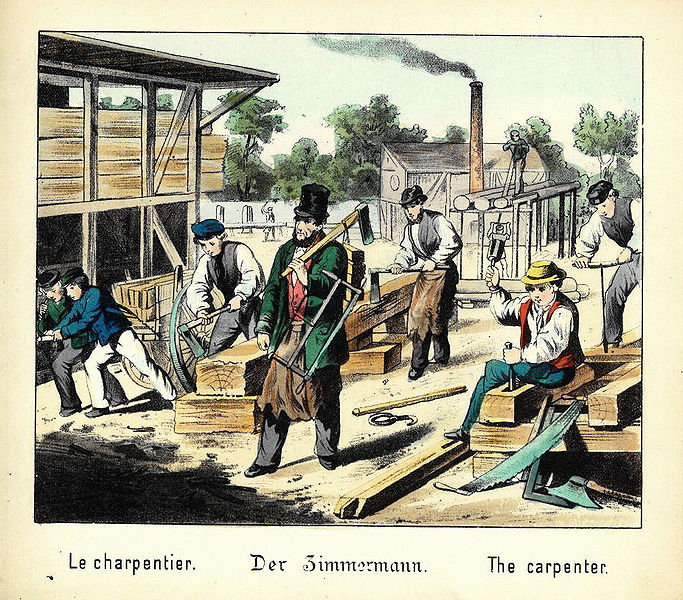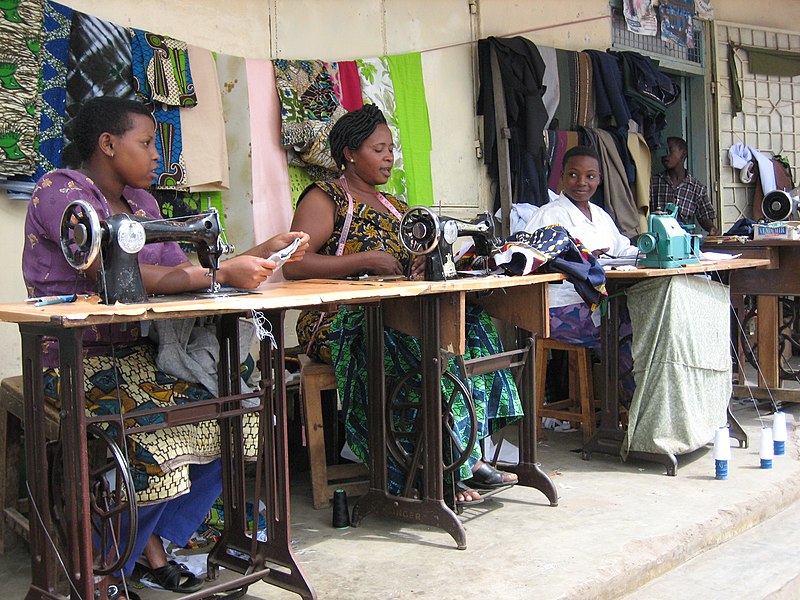3
What is the apprenticeship model?

Historically, there was hardly any formal training of craftsmen. The training took place under the watch of experienced craftsmen in working communities where the apprentice received continuous mentoring. The master demonstrated the correct way of completing a task, and afterwards the apprentice attempted to imitate the master’s skills, while being corrected for any mistakes.

This traditional model of apprenticeship originated in the European guilds of the Middle Ages. The guilds appeared in the 12th century. Before training began, the apprentice and the master craftsman would sign a legal contract, with specific terms for the training. The apprentice was required to sign an apprenticeship contract of several years before she could become a journeyman, a person fully trained in a trade or craft, but not yet a master craftsman (Skagen 2004:118). The Encyclopedia Britannica (2013 online edition) defines apprenticeship as: “training in an art, trade, or craft under a legal agreement that defines the duration and conditions of the relationship between master and apprentice”.1
The term “apprenticeship” can be used in two ways. The first to describe the statutory institutional structures that have dominated vocational education. The second is as a general metaphor for a relationship where a novice learns from an experienced person. The master knows how the work should be done. She models the work for the novice, who in turn tries to follow the master’s example. The last decade has seen a rebirth of the apprenticeship model, and many now consider the master-apprentice relation to be a good vocational learning model. The apprenticeship model has also been introduced outside of the traditional vocational education, as a general pedagogical model (Nielsen and Kvale 1999).

Usage
The apprenticeship model has a particularly strong foothold within vocational pedagogy (Skagen 2004: 118). As a metaphor, it refers to an asymmetrical relationship between two individuals, one who has mastered the skills of the trade (the master), and another who has not (the apprentice). Similar to a traditional teacher-student relationship, this model is based on one-way communication. During the process, the apprentice acquires tacit knowledge through observing the master as she uses her skills (Polanyi 1958). This perspective can also be used to analyze the interplay between parent and child. Through the participation in daily activities, children learn skills by observing their parents (Rogoff 1990). This kind of learning is sometimes described as observational learning (see Albert Bandura).
Characteristics
Nielsen and Kvale (1999:19) mention four characteristics of the apprenticeship model as a pedagogical idea:
– Professional identity: The apprentice learns by completing practical assignments that gradually become more difficult. The professional identity is developed through the process of mastering new skills. The reflective conversation should take place soon after the assignment, or it may not have the desired effect.
– Learning through imitation of the master: The novice observes and imitates the work of the master or other skilled workers in a community. The mentoring process follows a traditional pattern, starting with the master demonstrating the correct execution of an assignment. The apprentice then starts to practice, and is corrected by the master until she is proficient at the skill. The master will often give more in the beginning of the process,and gradually less.
– The quality of the work is evaluated through practice: The quality of a product is judged on its functionality and the customers’ feedback. The master governs the accumulated knowledge of the particular craft, and has developed subtle and complex criteria for the evaluation of craftsmanship. These criteria, however, are often characterized by tacit knowledge and are therefore not articulated. It´s therefore the master who selects the assignment which are appropriate for the apprentice.
The apprenticeship model is based on the assumption that competence can not be acquired through verbal communication alone. Competence is partly situational and improvisational. It can therefore be challenging for the master to find the balance between demonstrating how to complete an assignment and explaining it with words. Visualization, demonstration, observation and imitation are principal techniques.
Important theories
The theory of situated learning is central within the apprenticeship model (Lave and Wenger 1991). The focus is not on cognitive processes (see for instance cognitive learning theory), but on learning through interactions between individuals, cultural tools and social communities. Jean Lave and Etienne Wenger (1991) developed this theory by studying how craftsmen in African societies learn. Learning takes place by participating in a community of practice, which is “formed by people who engage in a process of collective learning in a shared domain of human endeavour”.2 In the community of practice, the apprentice is initially seen as a “legitimate peripheral participant”. The learning trajectory depends on the possibilities that are given to the individual in the community of learning (Nielsen and Kvale 1999).
With their focus on the community of practice, Lave and Wenger (1991) downplay the pedagogical importance of the master as an individual. The apprentice also learns a great deal from other apprentices and from trial and error. This approach is contradictory to Hubert and Stuart Dreyfus, who focus on how a novice learns from the master in a one-to-one relationship by observing and imitation. The novice does not necessarily need to be part of a larger social environment. This form of learning happens within both sports and research.

In the literature on communities of practice, the term scaffolding is used to describe how the instruction is adapted to the needs of the apprentice. Scaffolding means that the master offers support, and creates interest in the work for instance by simplifying practical assignments, explaining targets or evaluating the quality of the work produced by the apprentice. The master must also try at balance the apprentice’s frustration on one side and willingness to take risks on the other side (inspiration: Rogoff). The term scaffolding is similar to the term zone of proximal development, originally developed by Lev Vygotsky. The idea behind the zone of proximal development is that the novice can only learn new skills in a tailored situation, and with support from a more capable person. The teacher might be thinking out loud while solving mathematical problems, and giving the student an opportunity to develop strategies and problem solving. Observational learning is another important learning method, where the learner imitates a model’s novel behaviour through observation 3. This theory was originally introduced by Albert Bandura.
The importance of the apprenticeship model in many professions

Language often plays a subordinate role in the training of craftsmen, particularly during observation and demonstration. Most importantly, mentoring and practical work take place side by side. For instance, experienced architects mentor their students at the drawing board. Students are learning how to draw, while they are simultaneously discussing reasons behind their choices. According to Skagen (2004:19), Donald Schön rejects the notion that this form of apprenticeship simply means copying someone else’s actions. He argues that the novice instead uses these experiences to develop her own work style. Schön uses the terms reflective imitation, imitative reconstruction and selective reconstruction to describe these processes. The idea is that the students must enter into a relation of dependence, before being able to become independent. To illustrate, Skagen (2004) cites two personal narratives from one of Schön’s books, describing how architects mentor their students:
Criticism of the apprenticeship model
Some critics claim that the apprenticeship model has nothing to do with mentoring. Within the teacher education in Norway, for instance, mentoring courses have traditionally focused on the action-reflection model. The action-reflection model came as a reaction to the tradition of apprenticeship. According to critics the traditional apprenticeship model, dominant at that time, did little but cultivate “parrot teachers”. It has now become legitimate to include the apprenticeship model as one of several mentoring approaches in introductory books about mentoring pedagogy (Skagen 2004 and Løv 2009). This approach, however, emphasizes the importance of giving advice more than other mentoring approaches.
It is worth noting that some theories within the apprenticeship model also focus on group mentoring (i.e. the community of practice approach) in contrast to traditional mentoring approaches wihch usually focus on individual mentoring (i.e. the action-reflection model). In addition informal mentoring is more important within the apprenticeship model compared with the action-reflection model, which emphasizes formalized mentor-mentee conversations. Learning is considerd as the most important type of learning, while the action-reflection model maintains that the mentee should put thoughts into words. The critique against the apprenticeship model can be summarized in the following way:
– The apprenticeship model requires a close connection between reflection and the professional practice. Verbalization is not essential and the result might be less in-depth reflection.
– The apprenticeship model downplays the mentee’s right to formulate requests and criteria for own growth. Instead it is the vocational traditions which govern the mentoring practice. The mentoring approach criticizes progressive education which focus too much on creativity, self-development and learner autonomy.
– The fact that the master must be competent within a craft or a profession, limitates who can act as a mentor. Within the action-reflection model, it is more important that the mentor has communicative competence, that is the ability to develop good relations and ask good questions. Knowledge about the professional knowledge is not considered as equally important.
– The apprenticeship model has been criticized for valuing practice higher than theory. Excessive concern with mastering professional skills can undermine time used to learn important theoretical principles (Skagen 2004: 122-123).
Integration of the apprenticeship model in teacher education
In recent decades there has been a lot of focus on fostering reflective teachers in teacher education (Skagen 2004: 121). The didactic model of Hiim and Hippe4, for instance, builds on this idea. Skagen (2004: 125-126) critiizes this mentoring approach as being one-sided. The reflective conversation is dominant. Nowadays, the new teacher following initiation into the teaching profession is quickly provided full responsibilities for teaching with little opportunity to observe other teachers. Within the apprenticeship model, one could alternatively picture a situation where the student teacher is responsible for part of the teaching, until the final certification. When that is said, there is little empirical research to show which mentoring models are in fact used in the practicum of the teacher education.
Sources
– Hiim, Hilde og Else Hippe (2006). Undervisningsplanlegging for yrkesfaglærere. Oslo: Gyldendal akademisk forlag.
– Lave, Jean og Etienne Wenger (1991). Situated learning : legitimate peripheral participation. Cambridge: Cambridge University Press .
– Lave, Jean (2012). Lecture about apprenticeship and learning. (Video resource)
– Nielsen Klaus og Steinar Kvale (1999). Mesterlære: læring som sosial praksis. Oslo: Ad Notam Gyldendal.
– Polanyi, Michael (1958). Personal knowledge. London: Routledge and Kegan Paul.
– Rogoff, Barbara (1990). Apprenticeship in thinking: cognitive development in social context. New York: Oxford University Press.
– Skagen, Kaare (2004). I veiledningens landskap. Kristiansand: Høgskoleforlaget.

